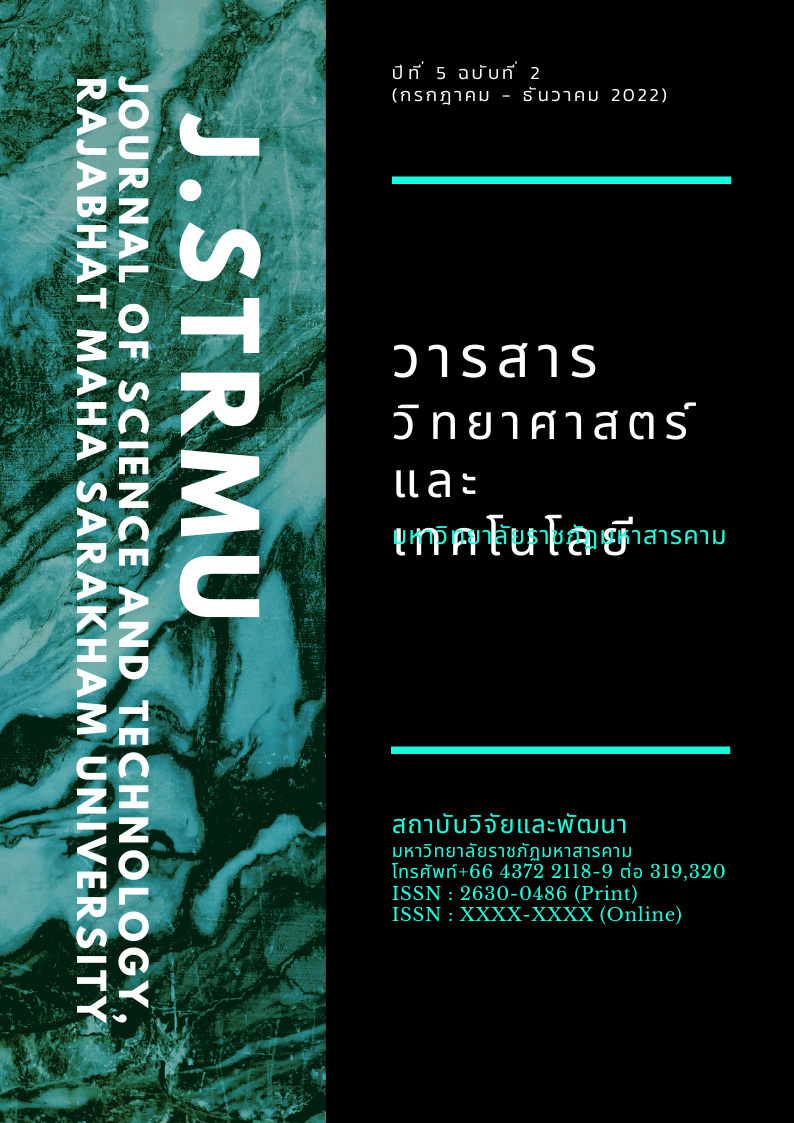ผลของโปรแกรมการฝึกดาบสองมือต่อทักษะทางสมองด้านการรู้คิดของนักศึกษามหาวิทยาลัยที่มีสุขภาพดี
คำสำคัญ:
ดาบสองมือ, ความสามารถทางสมอง, ความยืดหยุ่นทางความคิด, การควบคุมยับยั้งบทคัดย่อ
การวิจัยครั้งนี้เป็นการวิจัยเชิงทดลอง มีวัตถุประสงค์เพื่อเปรียบเทียบผลของโปรแกรมการฝึกดาบสองมือต่อทักษะทางสมองด้านการรู้คิดของนักศึกษาที่มีสุขภาพดีระดับมหาวิทยาลัย กลุ่มตัวอย่างได้มาจากการคำนวณขนาดตัวอย่าง ด้วยโปรแกรม G*Power 3.1.9.7 จำนวน 30 คน สุ่มกลุ่มตัวอย่างอย่างเป็นระบบ (เพศชาย 25 คน และเพศหญิง 5 คน) อายุระหว่าง 18-20 ปี (=19.23 ปี) เครื่องมือที่ใช้ในการวิจัย ได้แก่ เครื่องมือที่ในการทดลอง คือ โปรแกรมการฝึกดาบสองมือ จำนวน 8 สัปดาห์ สัปดาห์ละ 3 วัน (จันทร์ พุธ ศุกร์) และเครื่องมือที่ใช้ในการเก็บรวบรวมข้อมูลคือ แบบทดสอบเทรลเมคคิ่งและแบบทดสอบการออกแบบรูปภาพที่ไม่ซ้ำกันเพื่อทดสอบความยืดหยุ่นทางความคิด และแบบทดสอบแฟลงเคอร์เพื่อทดสอบความสามารถในการควบคุมและยับยั้ง ก่อนการทดลอง หลังการทดลอง 4 สัปดาห์ และหลังการทดลอง 8 สัปดาห์ วิเคราะห์ข้อมูลโดยใช้สถิติเชิงพรรณนา ได้แก่ ร้อยละ ค่าเฉลี่ย และส่วนเบี่ยงเบนมาตรฐาน และสถิติเชิงอนุมาน คือ การวิเคราะห์ความแปรปรวนทางเดียวแบบวัดซ้ำ และการทดสอบของฟรีดแมน กำหนดค่านัยสำคัญทางสถิติที่ระดับ 0.05 ผลการศึกษาพบว่า กลุ่มตัวอย่างมีค่าเฉลี่ยอัตราการเต้นของหัวใจขณะฝึก 145.93 ครั้งต่อนาที และมีค่าเฉลี่ยการรับรู้การออกแรงของร่างกายเท่ากับ 12.91 ความแปรปรวนของความสามารถทางสมองด้านการรู้คิดหลังการฝึก 8 สัปดาห์ พบว่า เวลาในการทดสอบความยืดหยุ่นทางความคิดของแบบทดสอบเทรลเมคคิ่งลดลง ความสามารถในการควบคุมและยับยั้งของแบบทดสอบแฟลงเคอร์ลดลง และจำนวนภาพที่ถูกต้องทั้งหมดของแบบทดสอบความสามารถในการออกแบบรูปภาพที่ไม่ซ้ำกันเพิ่มขึ้น อย่างมีนัยสำคัญทางสถิติ
เอกสารอ้างอิง
ชนะ ฤทธิธรรม และนิรุตติ์ สุขดี. (2564). การพัฒนาโปรแกรมการออกกำลังกายด้วยศิลปะการต่อสู้ประจำชาติไทยแบบดาบ
สองมือที่มีผลต่อคุณภาพชีวิตของนักเรียนชั้นมัธยมศึกษาตอนปลาย. วารสารวิทยาศาสตร์และเทคโนโลยี มหาวิทยาลัยราชภัฏศรีสะเกษ, 1(1), 48-60.
ประพันธ์ศิริ สุเสารัจ. (2556). การพัฒนาการคิด. กรุงเทพฯ: โรงพิมพ์ห้างหุ้นส่วนจำกัด 9119 เทคนิคพริ้นติ้ง.
ประรัญญา ไตรวงศ์. (2558). กระบี่กระบอง. เพชรบูรณ์: สถาบันการพลศึกษา วิทยาเขตเพชรบูรณ์.
ปริญญา ปทุมมณี. (2561). ผลของการออกกำลังกายด้วยด้วยการเล่นพื้นเมืองไทยที่มีต่อความฉลาดทางสติปัญญาในเด็กนักเรียน
ชั้นประถมศึกษาปีที่ 4-6. วารสารนาคบุตรปริทรรศน์ มหาวิทยาลัยราชภัฏนครศรีธรรมราช, 10(ฉบับพิเศษ), 282-288.
พงษ์เกษม สิงห์รุ่งเรือง. (2564). ผลของการจัดกิจกรรมพลศึกษาโดยใช้เกมการละเล่นพื้นบ้านโคราชที่มีต่อความคิดสร้างสรรค์ของ
นักศึกษามหาวิทยาลัยราชภัฏนครราชสีมา. วารสารสถาบันวิจัยและพัฒนา มหาวิทยาลัยราชภัฏมหาสารคาม, 8(2), 61-74.
ภาษา ทะรังศรี. (2558). ผลของการจัดกิจกรรมการเคลื่อนไหวโดยใช้แนวคิดการรับรู้ภาวการณ์เคลื่อนไหวของร่างกายที่มีต่อ
ความสามารถทางกลไกของเด็กออทิสติก ที่มีระดับสติปัญญาปานกลาง. วารสารอิเล็กทรอนิกส์ทางการศึกษา, 10(2), 465-470.
รังสกฤษฏิ์ บุญชลอ. (2550). กระบี่กระบอง. ปทุมธานี: สกายบุ๊กส์ จำกัด.
สดใส ดุลยา, ปริญญา เรืองทิพย์, และปิยะทิพย์ ประดุจพรม. (2562). ผลของความแตกต่างระหว่างเพศของนักเรียนระดับ
ประถมศึกษาที่มีต่อการเพิ่มเชาวน์ปัญญาด้านมิติสัมพันธ์ด้วยโปรแกรมการฝึกกระบวนการทางปัญญาเสมือนจริง (VR-CTP). วารสารมหาจุฬานาครทรรศน์, 6(7), 3354-3367.
สำนักการกีฬา กรมพลศึกษา. (2564). อิทธิพลของความสามารถทางสมองที่มีต่อระดับความสามารถทางการกีฬาของเยาวชน
ชายไทย : เครื่องมือสำหรับค้นหานักกีฬาที่มีพรสวรรค์. กรุงเทพฯ: บริษัท รีปริ้น จำกัด.
อัชรัฐ ยงทวี, ชัชฎาพร พิทักเสถียรกุล, ธิติวัฒน์ น้อยคำเมือง, และนิรุตติ์ สุขดี. (2563). ความฉลาดทางการกีฬา บทบาทของ
ความสามารถทางสมองที่มีต่อความสำเร็จทางกีฬาในนักกีฬาเยาวชนไทย (รายงานผลการวิจัย). กรุงเทพฯ: กรมพลศึกษา กระทรวงการท่องเที่ยวและกีฬา.
Adami, R., Pagano, J., Colombo, M., Platonova, N., Recchia, D., Chiaramonte, R., ... & Bottai, D. (2018).
Reduction of movement in neurological diseases: effects on neural stem cells characteristics. Frontiers in neuroscience, 12(2018), 336. doi: 10.3389/fnins.2018.00336
Cohen, J. (1988). Statistical Power Analysis for the Behavioral Sciences. New York University: New York.
Cona, G.; et al. (2015). It’sa matter of mind! Cognitive functioning predicts the athletic performance in ultra-
marathon runners. PLoS One, 10(7), e0132943.
Diamond, A. (2013). Executive functions. Annual review of psychology, 64(2013), 135-168.
Eysenck, M. W., & Brysbaert, M. (2018). Fundamentals of cognition. Routledge.
Gasser, T., Rousson, V., Caflisch, J., & Jenni, O. G. (2010). Development of motor speed and associated
movements from 5 to 18 years. Developmental medicine & child neurology, 52(3), 256-263.
Gourmaud, S, Shou, H, Irwin, D, Sansalone, K, Jacobs, L, Lucas, T, Davis, K, Jensen FE, Talos, D. (2020).
Alzheimer-like amyloid and tau pathology associated with cognitive deficit in temporal lobe epilepsy. Brain 143(1), 191-209.
Gunduz, H., Gunduz, G. B., Hilal, K. A. Y. A., Ozgu, İ. N. A. L., Gulveren, H., & Tavat, B. C. (2021). Norm
Determination Study of Trail Making Test, Enhanced Cued Recall Test and Clock Drawing Test for Turkish Sample Between 6-18 Years of Age. Archives of Neuropsychiatry, 58(4), 314.
Guure, C. B., Ibrahim, N. A., Adam, M. B., & Said, S. M. (2017). Impact of physical activity on cognitive decline,
dementia, and its subtypes: meta-analysis of prospective studies. BioMed research international, 2017.
Heisz, J. J., Clark, I. B., Bonin, K., Paolucci, E. M., Michalski, B., Becker, S., & Fahnestock, M. (2017). The effects of
physical exercise and cognitive training on memory and neurotrophic factors. Journal of cognitive neuroscience, 29(11), 1895-1907
Huijgen, B. C.; et al. (2015). Cognitive functions in elite and sub-elite youth soccer players aged 13 to 17 years.
PloS one, 10(12), e0144580.
Huizinga, M., & Van der Molen, M. W. (2007). Age-group differences in set-switching and set-maintenance on
the Wisconsin Card Sorting Task. Developmental neuropsychology, 31(2), 193-215.
Kalkut, E. L., Han, S. D., Lansing, A. E., Holdnack, J. A., & Delis, D. C. (2009). Development of set-shifting ability
from late childhood through early adulthood. Archives of Clinical Neuropsychology, 24(6), 565-574.
Klenberg, L., Korkman, M., & Lahti-Nuuttila, P. (2001). Differential development of attention and executive
functions in 3-to 12-year-old Finnish children. Developmental neuropsychology, 20(1), 407-428.
Kubo, M., Shoshi, C., Kitawaki, T., Takemoto, R., Kinugasa, K., Yoshida, H., ... & Okamoto, M. (2008). Increase in
prefrontal cortex blood flow during the computer version trail making test. Neuropsychobiology, 58
(3-4), 200-210.
Ploughman, M. (2008). Exercise is brain food: the effects of physical activity on cognitive function.
Developmental neurorehabilitation, 11(3), 236-240.
Solso, R.L., MacLin, M. K., & MacLin, O. H. (2005). Cognitive psychology (7thEdition). Boston: Pearson Education,
Inc.
Tomporowski, P. D., Davis, C. L., Miller, P. H., & Naglieri, J. A. (2008). Exercise and children’s intelligence,
cognition, and academic achievement. Educational psychology review, 20(2), 111-131.
Yang, Y., & Raine, A. (2009). Prefrontal structural and functional brain imaging findings in antisocial, violent, and
psychopathic individuals: a meta-analysis. Psychiatry Research: Neuroimaging, 174(2), 81-88.



